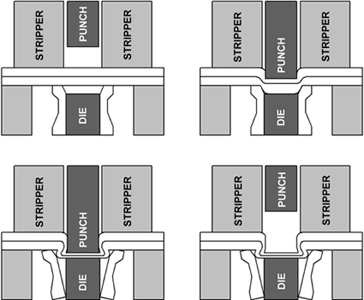Clinching is the processes of joining sheet metal by drawing a circular button through two sheets, forming a mushroom shape, interlocking them together. The interlocking feature forms water tight, permanent, joints between them. Clinching provides a cleaner alternative to riveting and spot welding. The process doesn’t create any sparks, leave burn marks, or require consumable fasteners. In addition to a clean finished look clinches are consistent, water tight, strong and vibration resistant.
Clinching has advantages over both riveting and spot welding. There is no sparking or burning caused by spot welding. Clinching can consistently fasten mismatched materials, a task at which spot welding often falls short. Riveting requires fasteners which have a cost associated with each join. Fasteners also require pre-punched holes to form and align during the fabrication process.
 Process
Process
Clinching is essentially a 4 step process.
- The sheets are clamped together between a stripper plate and bottom plate. This not only holds the metal in place during the forming, but also limits the area of metal drawn into the button. This prevents deformation around the feature.
- A punch tip is then forced down past the surface of the bottom sheet. The punch is designed to draw the metals together without shearing or cracking the surface.
- The punch tip then presses the sheets against a bottom die. The pressure from the punch causes the metal to flow; the bottom die then directs the flow outwards forming the mushroom shape necessary to join the sheets.
- Finally the stripper plate holds the sheets in place while the punch tip is retracted. This process takes place in a single quick stroke.
Clinching Video
An excellent video from the makers of Tog-L-Lock showing the material flow of clinched sheet metal. Here you can see the detail of the die tip being slightly dome shaped, assisting the lateral flow of the metal during the join.
Resources
- Engineering Standards Tog-L-Lock / Lance-N-Lock Information – Inspiration for this post, great information on clinching, terminology and technology.
- Overview of the TOX-Clinching Technology – Solid technical resources from one of the industry leaders in clinching technology.